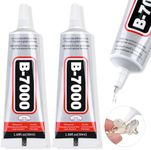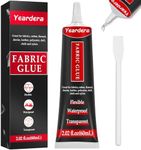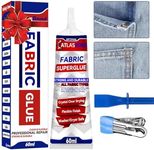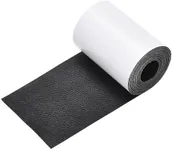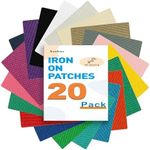Buying Guide for the Best Permanent Fabric Glues
Choosing the right permanent fabric glue can make a significant difference in the durability and appearance of your fabric projects. Whether you're working on clothing, upholstery, or crafts, understanding the key specifications of fabric glues will help you select the best product for your needs. Here are the essential factors to consider when picking a permanent fabric glue.Drying TimeDrying time refers to how long it takes for the glue to set and become permanent. This is important because it affects how quickly you can handle or use the glued fabric. Fast-drying glues are ideal for quick projects or when you need to move on to the next step quickly. However, they may not allow much time for adjustments. Slower-drying glues give you more time to reposition the fabric but require patience. Choose a drying time that matches your project needs and your working pace.
FlexibilityFlexibility indicates how well the glue can bend and stretch with the fabric without cracking or breaking. This is crucial for clothing and items that will be frequently handled or moved. High flexibility is essential for wearable items and fabrics that need to maintain their softness and pliability. For more rigid applications, such as decorative pieces or upholstery, flexibility may be less critical. Consider how much movement and flexibility your project will require when selecting a glue.
WashabilityWashability refers to the glue's ability to withstand washing and cleaning without losing its adhesive properties. This is particularly important for clothing and items that will be laundered regularly. Glues that are labeled as washable are designed to endure multiple wash cycles without degrading. If your project involves items that will be washed frequently, ensure the glue is specifically formulated to be washable. For items that won't be washed often, this may be less of a concern.
Bond StrengthBond strength measures how strong the adhesive hold is once the glue has dried. This is important for ensuring that the fabric pieces stay securely attached over time. Stronger bond strength is necessary for heavy-duty fabrics and items that will experience a lot of wear and tear. For lighter fabrics and less demanding applications, a moderate bond strength may be sufficient. Assess the weight and intended use of your fabric to determine the appropriate bond strength.
Applicator TypeThe applicator type refers to the design of the glue's dispensing mechanism, such as a nozzle, brush, or pen. This affects how easily and precisely you can apply the glue. Fine-tip nozzles are great for detailed work and small areas, while brushes or wider applicators are better for covering larger surfaces quickly. Choose an applicator type that suits the scale and detail of your project to ensure a neat and efficient application.
Drying TransparencyDrying transparency indicates whether the glue dries clear or remains visible after drying. This is important for the aesthetic finish of your project. Clear-drying glues are ideal for visible areas where you don't want the glue to be noticeable. If the glued area will be hidden or if the appearance of the glue doesn't matter, this may be less important. Consider the visibility of the glued areas in your project when choosing a glue with the appropriate drying transparency.
